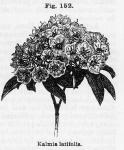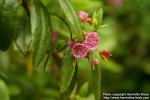 Preparation: Tincture of Kalmia
Preparation: Tincture of Kalmia
Related entries: Oxydendron.—Sourwood Tree
- Rhododendron.—Rosebay
The leaves of Kalmia latifolia, Linné.
Nat. Ord.—Ericaceae.
COMMON NAMES: Mountain laurel, Laurel, Sheep laurel, etc. (see below).
 Botanical Source and Description.—This plant is known by various names in different sections of the country, as Laurel, Lambkill, Ivy, Big-leaved ivy, Spoonwood, Calico-bush, Mountain laurel, etc. It is a beautiful shrub, from 4 to 8 feet high, sometimes attaining the height of a small tree, with crooked stems and a rough bark. The leaves are irregularly alternate and ternate, evergreen, coriaceous, very smooth, with under side somewhat paler, ovate-lanceolate, acute at each end, entire, on long petioles at the ends of the branches, from 2 to 3 inches long. The flowers are numerous, white or variously tinged with red, very showy, clammy, in splendid terminal, viscid-pubescent, simple or compound corymbs, with opposite branches. The pedicels are glutinous and pubescent, with ovate, acuminate bracts. Calyx small, 5-parted, and persistent, with oval acute segments. The corolla is large, monopetalous, with a conical tube, a cyathiform limb, and an erect, shallowy, 5-lobed margin; at the circumference of the limb, on the inside, are 10 niches or pits, accompanied with corresponding prominences on the outside; in these depressions the anthers are found lodged at the time when the flower expands. The stamens are 10, hypogynous, bent outwardly so as to lodge their anthers in the niches of the corolla, but liberating them during the period of flowering and striking against the sides of the stigma; anthers 2-celled with 2 terminal pores. The ovary is roundish, supporting a slender, declinate style longer than the corolla; stigma obtuse. The fruit is a dry capsule, which is roundish, depressed, 5-celled, 5-valved, the valves alternating with the divisions of the calyx. The seeds are numerous, and minute (L.—W.—B.—R.).
Botanical Source and Description.—This plant is known by various names in different sections of the country, as Laurel, Lambkill, Ivy, Big-leaved ivy, Spoonwood, Calico-bush, Mountain laurel, etc. It is a beautiful shrub, from 4 to 8 feet high, sometimes attaining the height of a small tree, with crooked stems and a rough bark. The leaves are irregularly alternate and ternate, evergreen, coriaceous, very smooth, with under side somewhat paler, ovate-lanceolate, acute at each end, entire, on long petioles at the ends of the branches, from 2 to 3 inches long. The flowers are numerous, white or variously tinged with red, very showy, clammy, in splendid terminal, viscid-pubescent, simple or compound corymbs, with opposite branches. The pedicels are glutinous and pubescent, with ovate, acuminate bracts. Calyx small, 5-parted, and persistent, with oval acute segments. The corolla is large, monopetalous, with a conical tube, a cyathiform limb, and an erect, shallowy, 5-lobed margin; at the circumference of the limb, on the inside, are 10 niches or pits, accompanied with corresponding prominences on the outside; in these depressions the anthers are found lodged at the time when the flower expands. The stamens are 10, hypogynous, bent outwardly so as to lodge their anthers in the niches of the corolla, but liberating them during the period of flowering and striking against the sides of the stigma; anthers 2-celled with 2 terminal pores. The ovary is roundish, supporting a slender, declinate style longer than the corolla; stigma obtuse. The fruit is a dry capsule, which is roundish, depressed, 5-celled, 5-valved, the valves alternating with the divisions of the calyx. The seeds are numerous, and minute (L.—W.—B.—R.).
History.—Sheep laurel, or more properly Mountain laurel, inhabits most parts of the United States, on rocky bills and elevated grounds, and in damp soil, sometimes forming a dense thicket, with a profusion of beautiful rose-colored flowers which appear in June and July, forming a contrast with its dark, glossy, green leaves. The leaves are reputed to be poisonous to sheep and several other animals, killing them; while others again, as deer, goats, and partridges, feed upon them without any unpleasant consequences. When partridges, which have eaten the laurel leaves, have themselves been cooked and eaten, they are said to have occasioned sickness at stomach, headache, impaired vision, difficult breathing, coldness of the surface and extremities, and other symptoms similar to those caused when putrid meats are eaten. An emetic of mustard with warm water has relieved some of the above symptoms by removing the poison from the stomach. It is very doubtful, however, whether these symptoms were caused by the poisoned flesh of the birds, as numerous persons eat partridges that have fed on these leaves, without the least inconvenience. The Indians are said to have used the expressed juice of the leaves, or a strong decoction, for the purpose of committing suicide. They also made spoons of the wood, hence the name spoonwood. The leaves, which are astringent and bitter (described above), are the medicinal parts, and yield their virtues to alcohol or water.
Chemical Composition.—The leaves contain, according to Mr. C. Bullock, fatty matter, resin, tannic acid, gum, a body somewhat like mannit, chlorophyll, wax, albumen, an acrid substance, extractive, yellow coloring matter, and various salts (Amer. Jour. Pharm., Vol. XX, p. 264). Mr. G. W. Kennedy (1875) isolated arbutin in small quantity. The poisonous principle is andromedotoxin (C31H51O10), a neutral body, found by Prof. Plugge in several poisonous, ericaceous plants (see also investigation by A. J. M. Lasché, Pharm. Rundschau, 1889, p. 208). It is soluble in water (1 in 35), chloroform (1 in 400), alcohol (1 in 9), and almost insoluble in ether (1 in 1400). The diluted mineral acids, when warm, impart to it a beautiful red color. Miss De Graffe (Amer. Jour. Pharm., 1896, p. 321), found tannin resembling oak-tannin in the stems and leaves of mountain laurel. Mr. Harry Matusow (Amer. Jour. Pharm., 1897, p. 341) analyzed the root of Kalmia latifolia, which contained 11.4 per cent of starch, 1.24 per cent of ash, tannin resembling oak-tannin, etc. The ether extract contained a substance which gave reactions for andromedotoxin.
Action, Medical Uses, and Dosage.—In immoderate doses, sheep laurel is a poisonous narcotic, producing the symptoms above named, with diminished circulation. In medicinal doses, it is antisyphilitic, sedative to the heart, and somewhat astringent. Internally, either in powder, decoction, or tincture, it is an efficient remedy in primary or secondary syphilis, and will likewise be found invaluable in febrile and inflammatory diseases and hypertrophy of the heart, allaying all febrile and inflammatory action, and lessening the action of the heart. In active hemorrhages, diarrhoea, and flux, it has been employed with excellent effect, and will be found useful in overcoming obstinate chronic irritation of mucous surfaces. I have extensively used this agent, and regard it as one of our most efficient agents in syphilis; and have likewise found it very valuable in inflammatory fevers, jaundice, and ophthalmic neuralgia and inflammation. The remedy must always be used with prudence; and should any of the above mentioned symptoms appear, the dose must be diminished, or its use suspended for a few days. In cases of poisoning by this article, stimulants, as brandy, whiskey, etc., must be given, with counter-irritation to the spine and extremities. Sheep poisoned by eating the leaves, have been saved by administering 1 or 2 gills of whiskey to them (King). Scudder (Spec. Med.), states that he has employed it with marked advantage in secondary syphilis and atonic chronic inflammations. For the treatment of aching pains in the muscles of the face, muscular rheumatism with shifting pains, and in the early stage of rheumatism of the heart, success has been claimed for this drug, the specific medicine being used in from 1 to 5-drop doses. Bright's disease (?) is asserted to have been benefited by its use. Pain in the back during the menstrual period, and pain upon moving the eyes are said to be relieved by kalmia. Externally, the fresh leaves stewed in lard, or the dried leaves in powder mixed with lard to form an ointment, are said to be beneficial in tinea capitis, psora, and other cutaneous affections. "Some time since I treated a case of syphilis of five weeks' standing, which had not received any kind of treatment during that period. The patient, at the time I first saw him, had several chancres, the surface of the body and head was covered with small red pimples, elevated above a jaundiced skin, and he was in a very debilitated condition. I administered a saturated tincture of the leaves of kalmia, and touched the chancres with a tincture of chloride of iron, and effected a cure in 4 weeks, removing the jaundice at the same time" (King). The saturated tincture of the leaves or specific kalmia, are the best forms of administration; they may be given in doses of from 10 to 20 drops every 2 or 3 hours; the decoction may be given in doses of from ½ to 1 fluid ounce; and of the powdered leaves, from 10 to 30 grains. For acute disorders, particularly affections of the heart, from 5 to 20 drops of specific kalmia may be added to 4 fluid ounces of water, and the dilution administered in teaspoonful doses every hour. A salve made of the juice of the plant, forms an efficient local application for rheumatism. This remedy was a great favorite with Prof. King, especially for troubles depending primarily upon syphilitic infection.
Specific Indications and Uses.—Syphilis with excitation of the heart and circulation; rheumatism with shifting pains; cardiac excitation; cardiac palpitation excited reflexly from gastro-intestinal irritation; pain upon movement of the eyes.
 Related Species and Derivative.—There are other species of Kalmia, as Kalmia glauca, Aiton, or Swamp or Pale laurel, and Kalmia angustifolia, Linné, or Narrow-leaved laurel, which possess similar properties. The K. angustifolia is supposed by some to be the best of the species for medicinal use. Lasché, in 1889, found andromedotoxin in the leaves and twigs of the latter plant, as well as the berries of Kalmia latifolia. This plant is used by the Cree Indians as a tonic and remedy for intestinal irregularities.
Related Species and Derivative.—There are other species of Kalmia, as Kalmia glauca, Aiton, or Swamp or Pale laurel, and Kalmia angustifolia, Linné, or Narrow-leaved laurel, which possess similar properties. The K. angustifolia is supposed by some to be the best of the species for medicinal use. Lasché, in 1889, found andromedotoxin in the leaves and twigs of the latter plant, as well as the berries of Kalmia latifolia. This plant is used by the Cree Indians as a tonic and remedy for intestinal irregularities.
LAUROTETANINE.—M. Greshoff has found in a number of Laurel species a crystalline, toxic alkaloid (laurotetanine), soluble in an excess of alkali. It closely resembles strychnine in its action upon the spinal cord (Pharm. Jour. Trans., 1891, Vol. XXI, p. 662).

